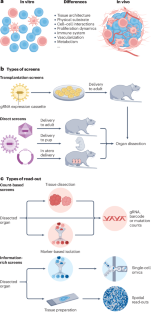Methods and applications of in vivo CRISPR screening
IF 52
1区 生物学
Q1 GENETICS & HEREDITY
引用次数: 0
Abstract
A fundamental goal in genetics is to understand the connection between genotype and phenotype in health and disease. Genetic screens in which dozens to thousands of genetic elements are perturbed in a pooled fashion offer the opportunity to generate large-scale, information-rich and unbiased genotype–phenotype maps. Although typically applied in reductionist in vitro settings, methods enabling pooled CRISPR–Cas perturbation screening in vivo are gaining attention as they have the potential to accelerate the discovery and annotation of gene function across cells, tissues, developmental stages, disease states and species. In this Review, we discuss essential criteria for understanding, designing and implementing in vivo screening experiments, with a focus on pooled CRISPR-based screens in mice. We also highlight how the resulting datasets, combined with advances in multi-omics and artificial intelligence, will accelerate progress and enable fundamental discoveries across basic and translational sciences. In vivo CRISPR screens generate high-throughput, unbiased genotype–phenotypes maps for complex biological processes that cannot be studied in vitro. This Review outlines key criteria for understanding, designing and implementing such screens and discusses their potential impact on basic and translational research.


体内CRISPR筛选的方法及应用
遗传学的一个基本目标是了解健康和疾病中基因型和表型之间的联系。在遗传筛选中,数十到数千个遗传元素以一种汇集的方式受到干扰,这为生成大规模、信息丰富和无偏倚的基因型-表型图谱提供了机会。虽然通常应用于体外还原,但在体内进行CRISPR-Cas混合微扰筛选的方法越来越受到关注,因为它们有可能加速发现和注释跨细胞、组织、发育阶段、疾病状态和物种的基因功能。在这篇综述中,我们讨论了理解、设计和实施体内筛选实验的基本标准,重点是基于crispr的小鼠筛选。我们还强调了由此产生的数据集,结合多组学和人工智能的进步,将如何加速进步,并使基础科学和转化科学的基础发现成为可能。
本文章由计算机程序翻译,如有差异,请以英文原文为准。
求助全文
约1分钟内获得全文
求助全文
来源期刊

Nature Reviews Genetics
生物-遗传学
CiteScore
57.40
自引率
0.50%
发文量
113
审稿时长
6-12 weeks
期刊介绍:
At Nature Reviews Genetics, our goal is to be the leading source of reviews and commentaries for the scientific communities we serve. We are dedicated to publishing authoritative articles that are easily accessible to our readers. We believe in enhancing our articles with clear and understandable figures, tables, and other display items. Our aim is to provide an unparalleled service to authors, referees, and readers, and we are committed to maximizing the usefulness and impact of each article we publish.
Within our journal, we publish a range of content including Research Highlights, Comments, Reviews, and Perspectives that are relevant to geneticists and genomicists. With our broad scope, we ensure that the articles we publish reach the widest possible audience.
As part of the Nature Reviews portfolio of journals, we strive to uphold the high standards and reputation associated with this esteemed collection of publications.
 求助内容:
求助内容: 应助结果提醒方式:
应助结果提醒方式:


